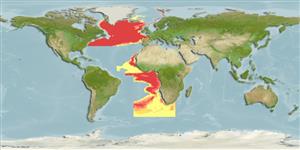>
Ophidiiformes (Cusk eels) >
Bythitidae (Livebearing brotulas)
Etymology: Thalassobathia: Greek, thalassa = the sea + Greek, bathis, -idos = a sting ray (Ref. 45335).
More on author: Cohen.
Environment: milieu / climate zone / depth range / distribution range
Ecologia
marinhas batipelágico; intervalo de profundidade 500 - 1000 m (Ref. 50610). Deep-water
Eastern Atlantic: two specimens between Ireland and Iceland (Ref. 4758) and one from the Gulf of Guinea; reported from Greenland (Ref. 9925) and Iceland (Ref. 12462). Northwest Atlantic: Georges Bank. Identification of specimen reported from the Bering Sea uncertain (Ref. 34024, 45907).
Tamanho / Peso / Idade
Maturity: Lm ? range ? - ? cm
Max length : 22.1 cm SL macho/indeterminado; (Ref. 6526)
Uncommon species, living in close association with the large jellyfish, Stygiomedusa sp. (Ref. 34024).
Life cycle and mating behavior
Maturidade | Reprodução | Desova | Ovos | Fecundidade | Larvas
Nielsen, J.G., D.M. Cohen, D.F. Markle and C.R. Robins, 1999. Ophidiiform fishes of the world (Order Ophidiiformes). An annotated and illustrated catalogue of pearlfishes, cusk-eels, brotulas and other ophidiiform fishes known to date. FAO Fish. Synop. 125(18):178p. Rome: FAO. (Ref. 34024)
Categoria na Lista Vermelha da IUCN (Ref. 130435: Version 2024-2)
Ameaça para o homem
Harmless
Utilização humana
Pescarias: sem interesse
Ferramentas
Relatórios especiais
Descarregue XML
Fontes da internet
Estimates based on models
Preferred temperature (Ref.
123201): 1.6 - 5.1, mean 3.8 °C (based on 24 cells).
Phylogenetic diversity index (Ref.
82804): PD
50 = 0.7500 [Uniqueness, from 0.5 = low to 2.0 = high].
Bayesian length-weight: a=0.01122 (0.00514 - 0.02450), b=3.04 (2.87 - 3.21), in cm total length, based on all LWR estimates for this body shape (Ref.
93245).
Nível Trófico (Ref.
69278): 3.5 ±0.5 se; based on size and trophs of closest relatives
Resiliência (Ref.
120179): Médio, tempo mínimo de duplicação da população 1,4 - 4,4 anos (Preliminary K or Fecundity.).
Fishing Vulnerability (Ref.
59153): Low vulnerability (17 of 100).
